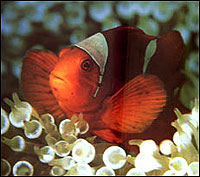Life on the reef
Linda Pitkin
Reef society: The social behaviour of coral fishes
Territorial behaviour

The spine-cheek anemonefish Premnas biaculeatus lives exclusively with the bulb-tentacle sea anemone Entacmaea quadricolor. (Image: Brian Pitkin)
Living at such close quarters on a coral reef, many fishes guard their territories against competitors and other unwelcome intruders. Sites guarded vary according to the lifestyle of the fish. Some have a permanent retreat, such as a goby's burrow or a moray's hole in the reef. Herbivorous damselfishes are fiercely protective of their feeding grounds and, like various other fishes, protect breeding and nesting sites. The first sign that most fishes give when their personal space is invaded is to spread their fins, and sometimes also the gill covers. If this fails to intimidate, they will make excited movements and sometimes warning sounds. As a last resort, they will chase the intruder away.
Social colours
Why are coral fishes often so colourful when camouflage is safer? The answer lies primarily in their social behaviour. On a heavily populated reef, interactions between fishes are frequent and the right response is vital. Does the confrontation call for a territorial display or for mating advances? A colour pattern that can be recognized rapidly is an advantage. Fishes that are active during the daytime and that live in the shallower zones have well-developed vision for a range of colours, sometimes including ultraviolet. In the clear water and abundant sunlight on the upper levels of a coral reef, bright colour patterns are visible for some distance, enabling a butterflyfish, for example, to distinguish its own kind immediately from the many others around. Colour is especially significant for many coral fishes at breeding times; sexual differences are common in some groups and heightened colours of males signal readiness to mate. Complex courtship rituals may even involve flashing eye-catching markings, usually on the fins, to woo a female. Fin flashing is also common in aggressive encounters, although deployed in a different manner. Rapid colour changes may occur in these situations and at other times, such as when a fish takes cover or prepares for the night.
Conspicuous marking may also be warning colours, labelling fishes as unsuitable to eat. Highly visible coral fishes need a line of defence against predators, and many of them have well-developed fin spines. Some are armed with razor-like blades (surgeonfishes) or are poisonous (certain pufferfishes). Warning coloration, of toxic fishes in particular, is sometimes mimicked by species that lack defensive toxins. A notable example is the striking resemblance of the blacksaddle filefish Paraluteres prionurus to the poisonous toby or sharpnose pufferfish Canthigaster valentini. Many fishes are patterned with contrasting bands, which are not always as conspicuous as might be supposed: such markings can break up the body shape, making it less obvious to an onlooker.
The clownfish and the sea anemone
Anemonefishes, commonly known as 'clownfishes', are members of the damselfish family that live in close and often specific association with sea anemones on Indo-Pacific reefs. An anemone often houses several fish. Although many large anemones are quite capable of living without anemonefishes, the fishes are so dependent on the protection of their hosts' stinging tentacles that they are never found anywhere else. The benefits of the partnership are not one-sided though: the fish drive away butterflyfishes that are inclined to eat an anemone's tentacles, and they may also clean away debris and parasites from the anemone.
The fish avoid getting stung by the stinging cells (nematocysts) of the anemone because they are protected by a coating of mucus. A substance in the mucus acts in a similar manner to the anemone's own protection against stinging itself--in each case the chemicals inhibit the firing of the stinging cells. A popular theory is that the fish acquires the mucus from the anemone as its body brushes against the tentacles. An alternative suggestion is that the immunity is an adaptation of the fish's own mucus. Either way, investigations have shown that the fish needs to interact frequently with its anemone, and can be stung after a long separation.
Not all coral fishes are brightly coloured, but those that are make an immediate and lasting impression on the observer. Drab fishes, on the other hand, may escape notice or be quickly passed by, but they are even more numerous. They are everywhere on a reef, in particular on the sea-bed, which provides a home for many gobies, scorpionfishes and others of all shapes and sizes.
Co-operative relationships
Not all relationships between different species are competitive or threatening. Some are of benefit to one or both participants, as in the symbiosis (living together) of anemonefishes and sea anemones, or prawn-gobies that share the burrows of blind prawns. Long-term partnerships and temporary liaisons are many and varied on a coral reef. One that most coral fishes cannot do without is the relationship with cleaners: chiefly certain small Indo-Pacific wrasses and Caribbean gobies, and also some shrimps, these perform a useful service by eating external parasites and dead or diseased skin. Cleaning stations are plentiful on a healthy reef and mostly serve a wide range of fish clients, although large oceanic visitors such as sharks and manta rays may have their own specific sites.
Reproduction and development
Coral fishes vary tremendously in reproductive behaviour. Their sex is not always fixed early: a change from female to breeding male is the norm in wrasses, parrotfishes and some groupers, while in anemonefishes the reverse change happens, from male to female. Some coral fishes bond in monogamous pairs, in others the male has a harem. Group mating and spawning occur in certain surgeonfishes and groupers.
Spawning often occurs late in the afternoon or at dusk, but also at other times for some fishes. The frequency of the event may be every other day, weekly, monthly or less often, and in many cases it is synchronized with the phases of the moon. The majority of coral fishes rise up in pairs to spawn in midwater, but some scatter their eggs on the sea-bed. Others go in for a degree of parental care, usually by the male. Damselfishes, and some triggerfishes and gobies, guard nests on the sea-bed, but only a few fishes go to the extreme of carrying the eggs around with them, in the mouth (jawfishes and cardinals) or in a pouch on the body (seahorses and pipefishes).
From hatchling to adult

A juvenile French angelfish Pomacanthus paru (left) and an adult French angelfish (right). The colour patterns of juveniles are spectacularly different to those of the adults. The young fish's bold stripes may advertise the fact that they sometimes act as cleaner fish to potential clients. (Left: Linda Pitkin, Right: Brain Pitkin)
Hatching from the eggs, the tiny larval fishes generally embark on a phase of life in open water away from the reef. During this time they form part of the plankton for between 10 to 100 days, the actual period depending on the species. They are transparent but extremely diverse in form, and often look markedly different from the adults. Some larval fishes have bizarre specializations such as long spines and filaments. Some are well developed as soon as they hatch, but many kinds of fishes start out dependent on a sizeable yolk sac. When that is used up, they must feed on the minute planktonic animals around them.
Larval fishes may travel varying distances during this period. It is a means of dispersal to new territories, and probably safer than remaining close to the reef where predators abound, but even so the delicate hatchlings face many dangers in the open ocean. The survivors eventually settle on a reef (or a seagrass bed adjacent to it) as juvenile fishes.
They usually arrive at night under cover of darkness and remain extremely vulnerable to predation for the first few weeks until they have learnt the ropes. Some new arrivals will have already undergone transformation to develop juvenile features, but others will be still small and not yet opaque. When the juvenile stage is reached, an individual may look like a smaller version of the adult, but this is not always so. In some cases the colour pattern is different from the one they will acquire in maturity--a striking example is seen in angelfishes of the genus Pomacanthus.
Toolbox

The Museum's smallest members of staff are our flesh-eating beetles, Dermestes maculates, who strip carcasses to the bone.